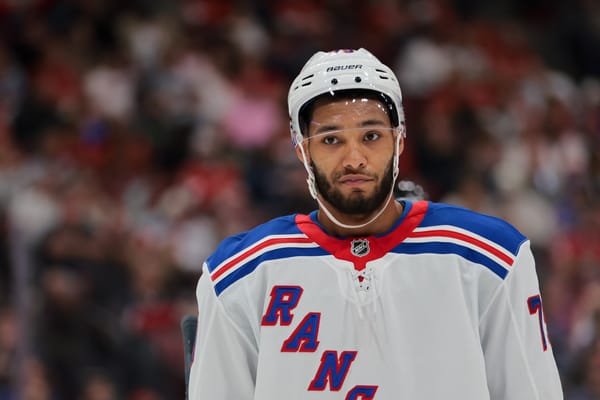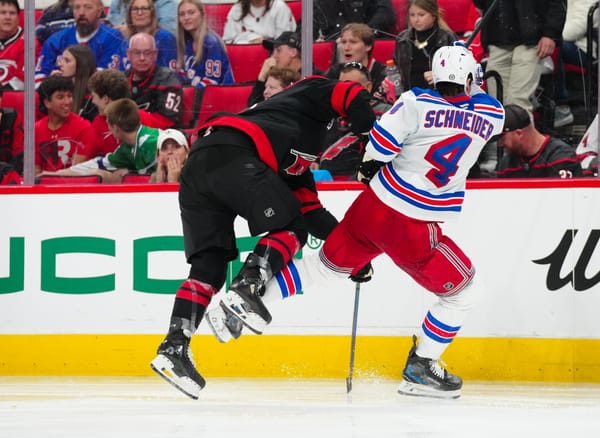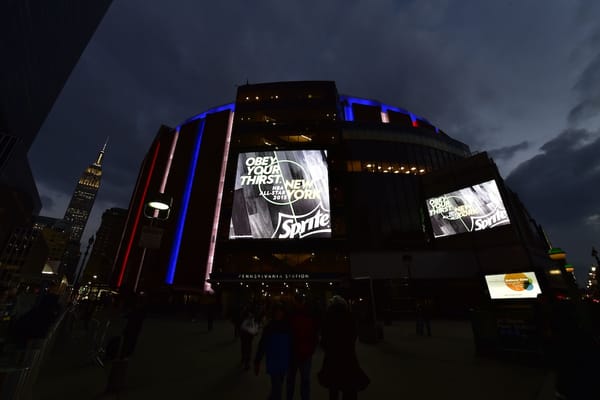What could the Rangers acquire with late first-round pick?
The New York Rangers have options this offseason, unlike seasons past. Management doesn’t have to maneuver them out of salary cap crunch, nor do they have to search for a way to replenish draft picks lost at the deadline in a Stanley Cup run that fell short.
But unlike years past, their season had a clear and definite expiration date that the team was aware of before it’s conclusion: April 7, the last day of the regular season.
Any hope of the playoffs deteriorated at the trade deadline, as the rebuilding Rangers sent a number of roster players elsewhere. Along with prospects, many of those returns featured draft picks.
Trading Rick Nash, Michael Grabner, Nick Holden, Ryan McDonagh, and J.T. Miller gave the Rangers a number of draft picks. This year, they not only have all of their draft picks in the first six rounds, but two more first-rounders (from Boston and Tampa Bay), another second-round pick (from New Jersey), and an additional third-rounder (from Boston).
All together, the Rangers have 10 draft picks this year; whether they actually make all 10 of those selections is another story. General manager Jeff Gorton, as reported by The Athletic, is keeping his options open this offseason to best facilitate the Rangers’ rebuild, and that could include moving a first-round pick for young talent that is closer to NHL-ready; as Gorton said, his team “can’t all be 18 (years old)… you need different age groups to build your team.”
The Rangers’ first-round pick will be 9th overall, unless they move up in the draft order. That pick, plus another one of their picks, roster players, or prospects, could help them move into better draft positioning. That pick likely isn’t on the move unless it’s used to add a more valuable draft pick. Instead, the first-rounders that could be on the move are those from the Tampa Bay Lightning and Boston Bruins.
Both the Lightning and Bruins are still in contention for the Stanley Cup, and at least one will reach the Eastern Conference Final, so both picks will be late in the draft order.
It’s possible to draft a skilled player late in the first round. The Rangers selected Filip Chytil 21st overall last year and Brady Skjei 28th overall in 2012. Around the rest of the league, in 2015 Brock Boeser and Travis Konecny were drafted 23rd and 24th, respectively, David Pastrnak was drafted 25th overall in 2014, Rickard Rakell went 30th overall in 2011, and in 2010 Kevin Hayes went 24th overall while Evgeny Kuznetsov was selected 26th. There’s no question that there’s potential in late first-round picks, but there’s also no question that the later the draft pick, the lower the value is.
Since the Rangers have 10 draft picks this year, plus they had two first-rounders last year after trading for the seventh overall pick (that was used to select Lias Andersson), and they have a conditional second-round pick that could become a first-rounder next season as well, moving a first-round pick may be in the Rangers’ best interest, because as Gorton said, the Rangers are going to need NHL-ready talent as well.
So what NHL-caliber players could the Rangers target for one of their first-round picks?
A first-round pick holds different value in the offseason than at the trade deadline, so the Rangers may want to look to past offseason trades to gauge that value.
High-level talent can come at a high price, and it’s something the Rangers have to be mindful of. If the Rangers are seeking an immediate impact player, it’s likely going to cost more than just a draft pick. As much as a young, NHL player improves their near-future chances, it could be detrimental to their long-term future, especially if they don’t use the deadline to replenish those picks next season, and instead feel they can push for the playoffs.
The Rangers have to find a way to increase the value of their first round pick, and that may start with looking at teams who don’t have a first-rounder this season. To minimize ask, maybe the most cost effective way for the Rangers to add a young player would be to look for one with an expiring contract.
In the west, the Calgary Flames are without their first- and second-round picks this season, as are the Nashville Predators. The Golden Knights sent their first-rounder to Detroit in the Tomas Tatar trade this year, while the Winnipeg Jets sent their first-rounder to St. Louis at the deadline for Paul Statsny.
In the East, the only team besides the Lightning and Bruins without a first-round pick, is the Pittsburgh Penguins.
So, are there any players on those teams that the Rangers could hope to acquire in exchange for a first-round pick (plus)?
The Jets have just over $5 million in cap space right now. Paul Stastny, Shawn Mattias, Matt Hendricks, Toby Enstrom, and Michael Hutchinson are all set to become unrestricted free agents this offseason. Adam Lowry, Joel Armia, Marko Dano, Brandon Tanev, Jacob Trouba, Tucker Poolman, Josh Morrissey, Joe Morrow, and Connor Hellebuyck will all be restricted free agents. While shedding some of their pending UFAs will help their cap situation, they’re still going to have to do some maneuvering to keep most of RFAs, while maintaining space for contracts that’ll expire the following year, like Patrik Laine’s and Kyle Connor’s.
Trouba would be a fantastic add for the Rangers – they undoubtedly need to add at least one defenseman this offseason after trading Ryan McDonagh – but he’s unrealistic. Him and Hellebuyck are the least likely of their pending free agents to be on the move, since they’re both key members of this team. There are other defensemen the Rangers could target though, like 23-year-old Josh Morrissey, whose entry-level contract is set to expire.
The Rangers already have Brady Skjei, Marc Staal, and possibly John Gilmour on the left. Brendan Smith is left-handed, but played the right side in New York. Whether Smith or Gilmour make this team is still a question, though. If both do, maybe one or more will shift to the right. Skjei was utilized on the right in Hartford too; while he hasn’t played much there at the NHL level, it could be something worth exploring if there are too many on the left, and if they feel Morrissey is the right defender to add to the top-four of their blue line.
If the Rangers instead focus on the right side of their defense, then maybe they target 24-year-old Poolman. He isn’t as experienced and when he’s played it’s been in more sheltered minutes, but he’s less established than Morrissey and doesn’t play as crucial of a role, which may make him more attainable.
As it stands, the Penguins have $272,056 in cap space. They only have one pending UFA (Carter Rowney), and five RFAs at the NHL level (Riley Sheahan, Dominik Simon, Bryan Rust, Tom Kuhnhackl, and Jamie Oleksiak). Daniel Sprong, who isn’t currently a roster player, is going to be an RFA at the end of this year as well. While the Rangers could inquire about some at the NHL level like Simon, 21-year-old Sprong would be an interesting target. There was speculation that he could have been moved at the trade deadline, plus the Penguins don’t exactly have has much roster space, especially if they retain all of their RFAs, which is bound to be a problem. A winger would not only fit the needs of the Rangers, but a first-round pick would fit those of the Penguins.
Vegas has six pending UFAs and five pending RFAs to deal with this offseason, and just over $6.2 million in cap space. They also are without their first-, third-, and seventh-round picks this year, although they do have two fours, two fifths, and two sixths. Still, in order to clear some roster and cap space, especially when they have prospects that could try to compete for roster spots next year, players could traded.
The most attractive may be 22-year-old Shea Theodore, whose ELC is set to expire. Of their defensemen though, retaining him may be their number one priority. He’s in for a raise from his $863,333 in cap hit though, which could cost them other players. Colin Miller is another RFA on their blue line, but the right-handed defenseman is 25-years-old; while that isn’t old, it’s not as young as the Rangers may be aiming for, like Theodore is. Since the Golden Knights were unsuccessful in adding Erik Karlsson at the deadline, they may not be willing to part with Theodore. On the other hand, if they make another push for a bonafide number one defensemen, then the Rangers and their draft pick could look to make a deal.
The Rangers can expand their search past teams that still have their first-round pick. The Buffalo Sabres may not be looking to replenish a lost draft pick, but rebuilding teams are often willing to absorb picks if the return is right.
The Sabres rebuild has dragged on through the years, and despite adding young, talented players, they still haven’t found any success, so they may look to make a change up front before they use their first overall pick to draft defenseman Rasums Dahlin, and that change could include pending RFA Sam Reinhart.
The hope could be that a new environment would help him reach the level that was expected of him when he was drafted. He isn’t quite a reclamation project for the Rangers, but he’s talented player with untapped potential. Plus, while he’s played center much of his career, he’s also able to play wing; that versatility could help the Rangers since it’s not definite whether Andersson or Chytil will play at the NHL level all next season. In return, the Sabres could ask for more than just a first-rounder, since there is that potential, so maybe one of the Rangers’ pending RFAs could be a part of the discussion as well since they have cap space to spare.
But for most of these players, the question that has to be considered is how much more than just a first-round pick would it cost?
The Rangers have options this offseason, and one option includes moving a late first-round pick for more NHL-ready talent to help facilitate their rebuild. While NHL-level talent is key moving forward, balancing the costs is imperative; they may have assets to spend now, but they can’t risk taking a step back by accelerating their rebuild.
*Salary cap data via CapFriendly




